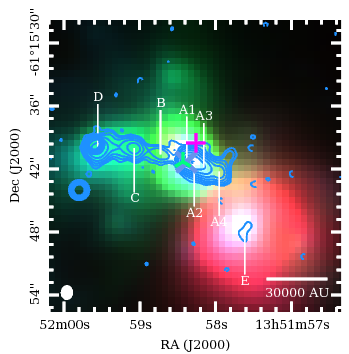Stellar Feedback
Jets and Outflows
When stars form, both accretion discs and jets of ionised material naturally arise from the mechanisms at work during their creation. Although they are frequently seen being ejected by forming low-mass stars, the observation of ionised jets towards more massive stars is much less common. As a consequence we understand relatively little about high-mass jets (and massive star formation) in comparison to their smaller brethren. Massive stars typically form at the centre of the densest parts of giant molecular clouds which exacerbates the problem by extinguishing much of their light, from which we would usually be able to glean information.

At Leeds we overcome this problem by observing these regions using radio telescopes which can peer through the gas and dust, to understand the ionised jets themselves. Recent work has shown that low- and high- mass jets are very similar and scale with a protostars age/mass in much the same way. Interestingly we also see types of radio emission which tell us both high-velocity shocks and magnetic fields are present in most cases. Since the actual mechanisms for how a jet forms around a massive star are currently unknown, this result has helped to show that magnetic fields are a regular ingredient, again much like low-mass examples. With more powerful telescopes available in the near future we hope to view the exact point of a jet's creation at an angular resolution about 50,000 times smaller than the angular size of the moon in the night sky. This will enable us to definitively answer many questions about the formation of massive, ionised jets and massive star formation in general.
Large Scale Feedback
Feedback has a powerful effect on the local environment of a star but also has significant repercussions further afield, influencing activity in the ISM on a galactic scale. The expulsion of matter from a star through winds and outflows heavily influence the ISM, sweeping up and compressing any material it runs into creating a turbulent medium. This can lead to the triggering of star formation or indeed the destruction of potential star forming clouds. The combined effect of feedback from a number of stars in a large cluster will significantly affect the local galactic star formation rate. Below is a simulation of feedback from a star cluster showing how the local environment evolves.
Through numerical simulations that include magnetic fields, self-gravity and photionisation the group plans to explore how stellar radiation, stellar winds and supernovae effect the evolution of gas where clusters form and to see how the initial cloud properties control the amount of energy escapes a cluster.
Studying star formation in the context of stellar feedback requires knowledge of a number of different astrophysical phenomena and how they interact; more on this can be seen in the winds and shocks page.
